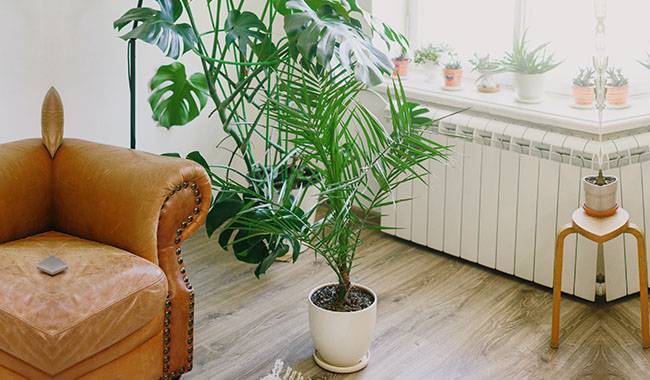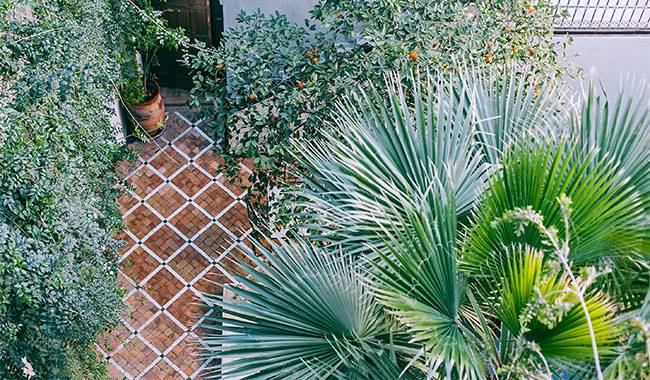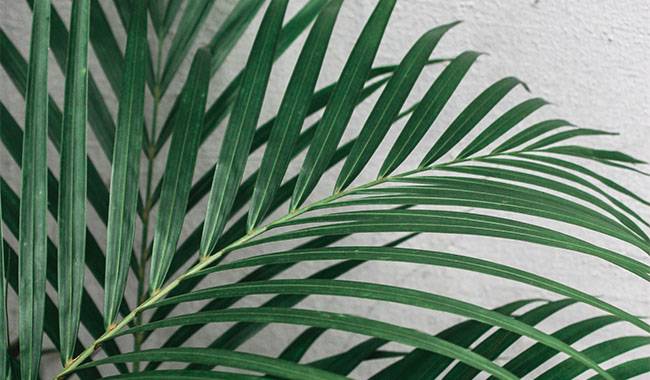
Growing indoor Palm trees is not difficult, but only if you carefully study the characteristics of the plants you choose. One of the most important considerations for any indoor Palm trees is overwintering. They can still adapt to house conditions from spring through fall, but overwintering with inadequate light and heating systems can be a real challenge for these legendary plants. To help overwinter Palm trees, lighting, temperature, and care all need to be adjusted correctly and in a timely manner. You will learn How to Take Care of Indoor Palm Trees in Winter in the ThumbGarden article.
Palm trees are the most popular large houseplants that are special not only in appearance but also in character. Although their size is dozens of times smaller than their natural counterparts, Palm trees do not change their habits in a room. Not only do they create a bright tropical atmosphere around them, changing the interior, but they also need to recreate their usual microclimate.
All Palm trees, without exception, are crops that require strict selection conditions and meticulous care by carefully following the recommended planting rules.
DIFFERENT PALM TREES REQUIRE DIFFERENT OVERWINTERING TEMPERATURES

Depending on whether they are from the subtropics or the tropics, not only is the choice of finding a comfortable location during the peak growth period different but also what kind of overwintering conditions Palm trees need. Subtropical Palm trees require cool, moderate temperatures; tropical Palm trees overwinter in warm or moderately warm conditions.
Palm trees will prefer stable temperatures year-round and will not tolerate cooler temperatures below 59-64 °F (15-18°C), even for short periods, including Dypsis yellowish, Cocos, Livistona, Geonoma, Rhopalostylis. Areca catechum, Lytocaryum, Latania lontaroides, Licuala, Acanthophoenix, Phoenix roebelenii, Euterpe oleracea, and Caryota softus prefer to overwinter at temperatures no lower than 64 °F (18 °C).
At moderate temperatures between 50-59 °F (10-15 °C), indoor Palm tree species such as Chamaedorea delicata, Sabal palm, and Branch prefer to overwinter.
On the other hand, European fan palm, Canary Island date palm, Trachycarpus fortunei, etc. can overwinter even at temperatures below 50 °F (10 °C) but not below 37-39 °F (3-4 °C). Optimal temperatures range from 41-46 °F (5-8 °C).
Palm trees are among the most sensitive plants to soil temperature. It is also worthwhile to ensure that the risk of uneven cooling of the substrate, disturbing the stability of the rootball temperature, is minimized. Containers should not be placed on cold surfaces (even if Palm trees are planted in wooden pots).
In winter, place floor plants in beds or on pedestals (if the house has floor heating, this will prevent the roots from overheating), place plants on windowsills away from windows, or move them from windows to pedestals.
If the temperature in the room is constantly fluctuating, it is worth considering additional protection for the pots to protect the roots – from placing them in a temporary container outside to wrapping them in insulating material. In addition, these extra “clothes” can be used as seasonal interior design decorations.
CORRECTING THE WAY PALM TREES ARE WATERED IN WINTER

All Palm trees, without exception, need to be watered slowly and less in the fall. Adapting to the correct period of winter moisture regime – is fundamental to maintaining attractive foliage, as less stress means also less risk.
Reduce watering according to how quickly and under what conditions the soil becomes dry.
1 . For Palm trees that overwinter in warmer conditions, continue to check that the soil has dried out by drying the substrate only a few more inches.
2 . For Palm trees overwintering in slightly cooler conditions, reduce watering by drying the soil a few times – to a third or half.
3 . For Palm trees in colder areas, keep watering to the minimum necessary to protect roots and greenery.
Species-specific recommendations should be followed. Overwatering is very dangerous for all Palm trees.
Watering with warm water is an important prerequisite and a measure to prevent many developmental problems in Palm trees. Winter should not be forgotten either, provided that “warm” means water that is a few degrees warmer than the air temperature.
For all heat-loving Palm trees, which prefer to overwinter at 64 °F (18°C) and above, it is best to keep the water temperature at the usually 86 °F (30°C), even in the middle of winter. For other species, conditions should be adjusted accordingly.
In winter, regardless of the temperature of Palm trees, drain the tray immediately after watering, without even waiting the standard 5 minutes. If there are signs that the bottom of the substrate is still too wet, you can replace the normal tray with a container filled with desiccant material (perlite, fine clay pebbles, or even sand).
By partially submerging the pot in such a substrate, you can help distribute the moisture more efficiently and prevent the lower third of the substrate in the container from getting wet. The same technique can be used for occasional overwatering, inadequate drainage holes, and soil compaction in winter, especially when kept below 50 °F (10 °C).
MAINTAIN AIR HUMIDITY
Air humidity is a key condition for the proper maintenance of Palm tree leaves during the winter months. it is already difficult for Palm trees to adapt to all the disadvantages of winter maintenance. And the air is very dry this time of year, causing dry tips and yellow spots on the luxurious foliage, not to mention the accelerated drying of older leaves.
Spraying is the best way to prevent the loss of ornamental value of Palm trees. Spray as needed, even for Palm trees overwintering in cooler temperatures, with a light spray of warm water, sometimes using spraying instead of watering.
FRESH AIR, BUT NO VENTILATION
All Palm trees, without exception, are at great risk of ventilation in winter. However, all Palm trees, regardless of their origin, also need regular ventilation and exposure to fresh air in winter, with no tolerance for air stagnation.
Free air circulation is just as important in cool overwintering environments as it is in warm overwintering environments. Special care should be taken to protect plants by shielding Palm trees from cold drafts and moving them out or taking them to other rooms. Any sudden changes in temperature and cold drafts can affect the plants.
If it is possible to move Palm trees off the premises, it is best to take advantage of this and bring them back when the temperature has stabilized.
NO NEED TO PRUNE PALM TREES!
If the leaves of Palm trees are injured, defaced, or wilted and need to be pruned, do not take it lightly. Any pruning of Palm trees, even dry Viagra, is strictly forbidden during the winter.
All winter damage can only be cut off before growth starts – early spring. The pruning rules remain standard: winter-damaged leaves are cut off leaving a strip of dry tissue just as dry leaves at any other time of the year, but no more than alive, healthy area. You can only cut off the wilt completely after the entire leaf disc and plug have dried out.
During the winter months, you must take special care to keep the leaves clean. Gently wiping with a soft sponge or sweeping with a brush to remove dust is an important measure to prevent the spread of pests and to disrupt effective photosynthesis.
Baths and showers, even in compact Palm trees in winter, can be very dangerous. Water treatment should only be used as a last resort in cases of severe contamination, using warm water and allowing the plants to dry in a warm room for a few days before transferring to their usual environment.







